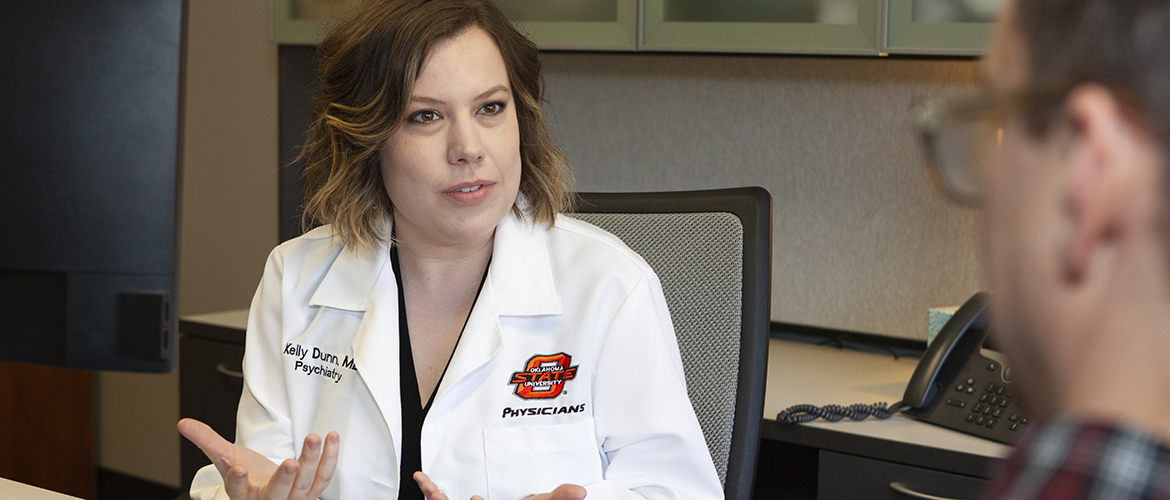Many Oklahomans struggling with substance abuse disorders have long had difficulty finding treatment, especially in rural areas.
The situation got worse as the response to the coronavirus outbreak made care options even more limited by temporarily closing clinics and treatment centers.
Meantime, self-isolation and job losses compounded problems for many of those most in need of help.
Dr. Kelly Dunn, a physician at Oklahoma State University’s Addiction Medicine Specialty Clinic, already had been working to increase access and better virtually connect with patients before the pandemic.
The Tulsa clinic, which opened in 2018, is part of the university’s health sciences center and treats about 250 patients affected by pain and substance use disorders. But the outbreak, which has affected her clinic’s operations to limit coronavirus exposure, magnified the urgency to provide addiction treatment across the state.
A $250,000 community health investment grant from Blue Cross and Blue Shield of Oklahoma may help improve treatment access in a state that ranks No. 1 nationally for nonmedical pain reliever consumption. This summer, the OSU clinic is opening satellite locations throughout Oklahoma to reach more people.
It will partner with local primary care facilities, where patients will go for telemedicine visits with OSU clinic providers. A health care professional at each facility will coordinate the visits and ensure patients receive the additional services they may need.
“We’re especially targeting rural areas where patients aren’t able to access addiction services,” Dunn says. “They’ll be working with providers they’re already familiar with and trust, while receiving recovery expertise.”
The cost of addiction
Oklahoma’s biggest public health problem is substance abuse, according to the state Department of Mental Health and Substance Abuse Services. Substance abuse costs the state an estimated $7 billion, including costs for health care, public safety and social services.
The department estimates 160,000 adult Oklahomans and about 20,000 teenagers need drug or alcohol addiction treatment. However, nearly 40% of Oklahoma’s estimated 3.8 million residents live in rural areas, where behavioral health and addiction treatment can be difficult to access.
“There is no simple solution to helping people,” says Joseph R. Cunningham, M.D., president of Blue Cross and Blue Shield of Oklahoma. “We have to look for innovative ways to help people, to keep people in their homes and working to support their families.”
He believes OSU’s efforts to improve treatment access through telemedicine is among a suite of models that could help Blue Cross and Blue Shield members, as well as all Oklahoma residents.
Improving treatment access
Although an estimated 21 million Americans have a substance use disorder involving alcohol and drugs, fewer than one in five people receive treatment, according to a Harvard University study published in the December 2018 issue of the journal Health Affairs. Reasons included provider shortages, particularly in rural areas.
Yet, researchers found overall use of telemedicine to treat patients with substance use disorders remains low despite the large number of people who could potentially benefit from it.
However, since the coronavirus outbreak, providers, including Dunn, have been using telemedicine to see patients while their offices limit operations. Dunn is determined to find more progressive ways to improve access to substance abuse disorder treatment, helping people become engaged in treatment and more productive. She knows patients can thrive after receiving treatment because they learn skills needed for success.
“There are so many obstacles to getting addiction treatment,” Dunn says. “Even for the ones who can make it, getting to a clinic is difficult at times.”
This year, she plans to launch a long-term study to determine whether patients at the satellite locations are willing to use virtual tools and remain engaged in their treatment. The results may help develop ways to better reach people in the Tulsa area and statewide, and establish innovative, evidence-based substance use disorder treatments to be used by other providers.
“That’s really what’s at the heart of this grant,” she says. “This definitely feels like the right place and the right time when everything comes together to really make an impact in Oklahoma.”

